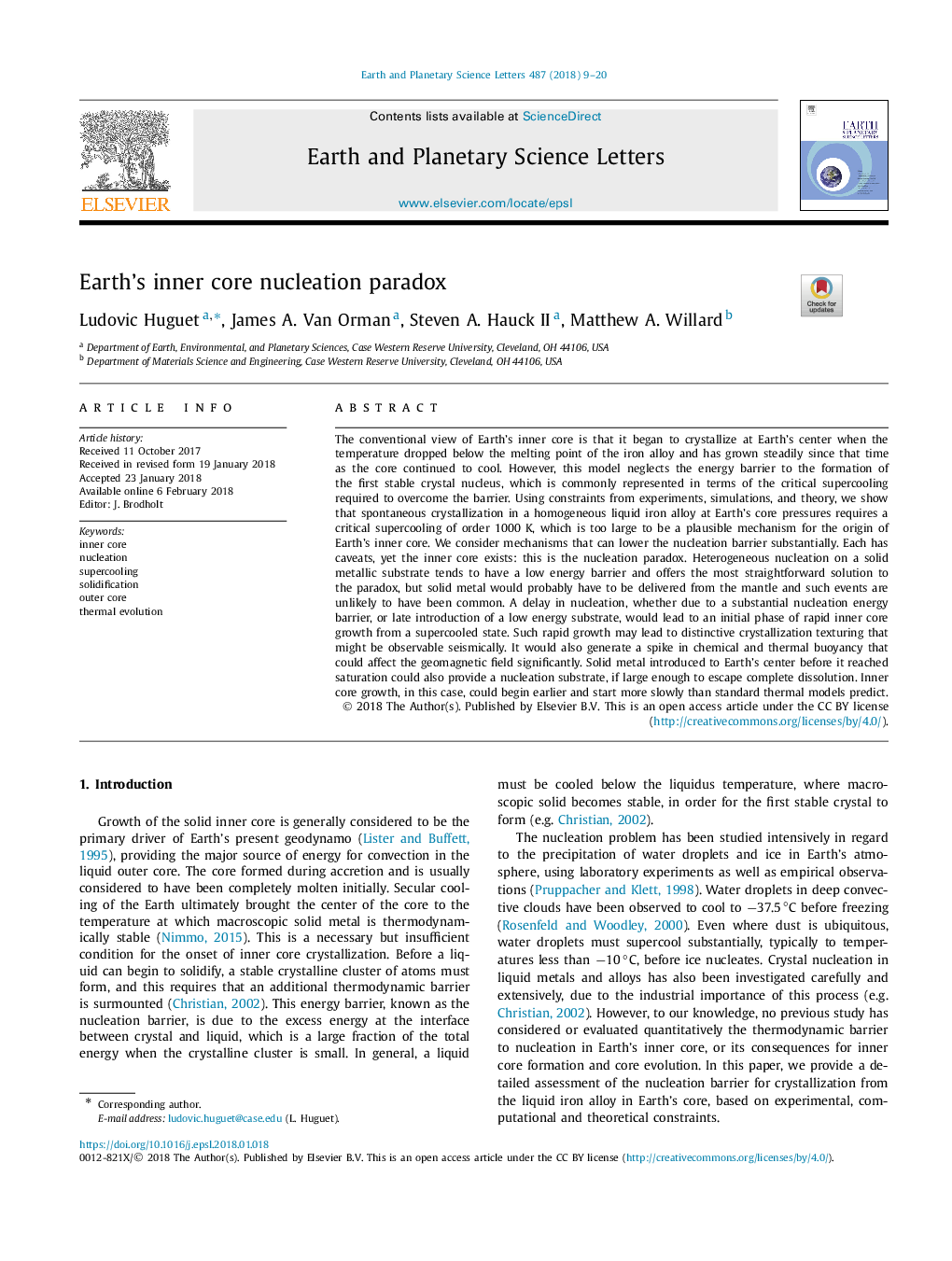| کد مقاله | کد نشریه | سال انتشار | مقاله انگلیسی | نسخه تمام متن |
|---|---|---|---|---|
| 8907062 | 1634669 | 2018 | 12 صفحه PDF | دانلود رایگان |
عنوان انگلیسی مقاله ISI
Earth's inner core nucleation paradox
ترجمه فارسی عنوان
پارادوکس هسته اصلی هسته زمین
دانلود مقاله + سفارش ترجمه
دانلود مقاله ISI انگلیسی
رایگان برای ایرانیان
کلمات کلیدی
هسته داخلی، هسته، باز هوشی انجماد، هسته بیرونی، تکامل حرارتی،
ترجمه چکیده
دیدگاه متداول هسته داخلی زمین این است که در مرکز زمین کریستال شده است، زمانی که درجه حرارت پایین تر از نقطه آلیاژ آلیاژ آهن پایین می آید و از آن زمان به بعد هسته ای همچنان خنک شده است. با این حال، این مدل مانع انرژی برای تشکیل اولین هسته پایدار کریستال است، که معمولا از لحاظ بروز خنثی بحرانی مورد نیاز برای غلبه بر مانع، از نظر مانع است. با استفاده از محدودیت های آزمایش ها، شبیه سازی ها و تئوری، ما نشان می دهد که بلوری شدن خود به خودی در یک آلیاژ آهن مایع همگن در فشار هسته ای زمین، نیازمند یک بحرانی بحرانی بحرانی 1000 کیلووات است که به اندازه کافی مکانیسم قابل قبولی برای هسته اصلی هسته زمین است . ما مکانیسم هایی را می توانیم که مانع هسته سازی را به طور قابل توجهی کاهش دهند. هر کدام دارای نقاط ضعف است، اما هسته داخلی وجود دارد: این پارادوکس هسته ای است. هسته زیستی ناهمگن بر روی یک بستر فلزی جامد تمایل دارد که دارای مانع انرژی کم باشد و راه حل ساده ای برای پارادوکس ارائه می دهد، اما احتمالا باید از فلز گوشتی به فلز جامد منتقل شود و بعید به نظر می رسد چنین رویدادی شایع باشد. تاخیر در هسته سازی، چه به علت یک مانع انرژی هسته ای قابل توجهی، و چه بعد از معرفی یک زیربنای انرژی کم، منجر به فاز اولیه رشد هسته سرطانی درونی از یک حالت فوق خنک می شود. چنین رشد سریع ممکن است منجر به شکل گیری متمایز شدن کریستالیزاسیون شود که ممکن است از لحاظ لرزه ای قابل مشاهده باشد. این همچنین موجب افزایش شیب شیمیائی و حرارتی می شود که می تواند به طور چشمگیری بر زمینه زمین شناسی تاثیر بگذارد. فلز جامد به مرکز زمین قبل از رسیدن به اشباع نیز می تواند یک بستر هسته ای ایجاد کند، اگر به اندازه کافی بزرگ باشد تا از انحلال کامل فرار کند. رشد هسته داخلی، در این مورد، می تواند زودتر شروع و شروع به آرامی کندتر از مدل های استاندارد حرارتی پیش بینی کند.
موضوعات مرتبط
مهندسی و علوم پایه
علوم زمین و سیارات
علوم زمین و سیاره ای (عمومی)
چکیده انگلیسی
The conventional view of Earth's inner core is that it began to crystallize at Earth's center when the temperature dropped below the melting point of the iron alloy and has grown steadily since that time as the core continued to cool. However, this model neglects the energy barrier to the formation of the first stable crystal nucleus, which is commonly represented in terms of the critical supercooling required to overcome the barrier. Using constraints from experiments, simulations, and theory, we show that spontaneous crystallization in a homogeneous liquid iron alloy at Earth's core pressures requires a critical supercooling of order 1000 K, which is too large to be a plausible mechanism for the origin of Earth's inner core. We consider mechanisms that can lower the nucleation barrier substantially. Each has caveats, yet the inner core exists: this is the nucleation paradox. Heterogeneous nucleation on a solid metallic substrate tends to have a low energy barrier and offers the most straightforward solution to the paradox, but solid metal would probably have to be delivered from the mantle and such events are unlikely to have been common. A delay in nucleation, whether due to a substantial nucleation energy barrier, or late introduction of a low energy substrate, would lead to an initial phase of rapid inner core growth from a supercooled state. Such rapid growth may lead to distinctive crystallization texturing that might be observable seismically. It would also generate a spike in chemical and thermal buoyancy that could affect the geomagnetic field significantly. Solid metal introduced to Earth's center before it reached saturation could also provide a nucleation substrate, if large enough to escape complete dissolution. Inner core growth, in this case, could begin earlier and start more slowly than standard thermal models predict.
ناشر
Database: Elsevier - ScienceDirect (ساینس دایرکت)
Journal: Earth and Planetary Science Letters - Volume 487, 1 April 2018, Pages 9-20
Journal: Earth and Planetary Science Letters - Volume 487, 1 April 2018, Pages 9-20
نویسندگان
Ludovic Huguet, James A. Van Orman, Steven A. II, Matthew A. Willard,
